Apr 29, 2019 | Questions & Answers
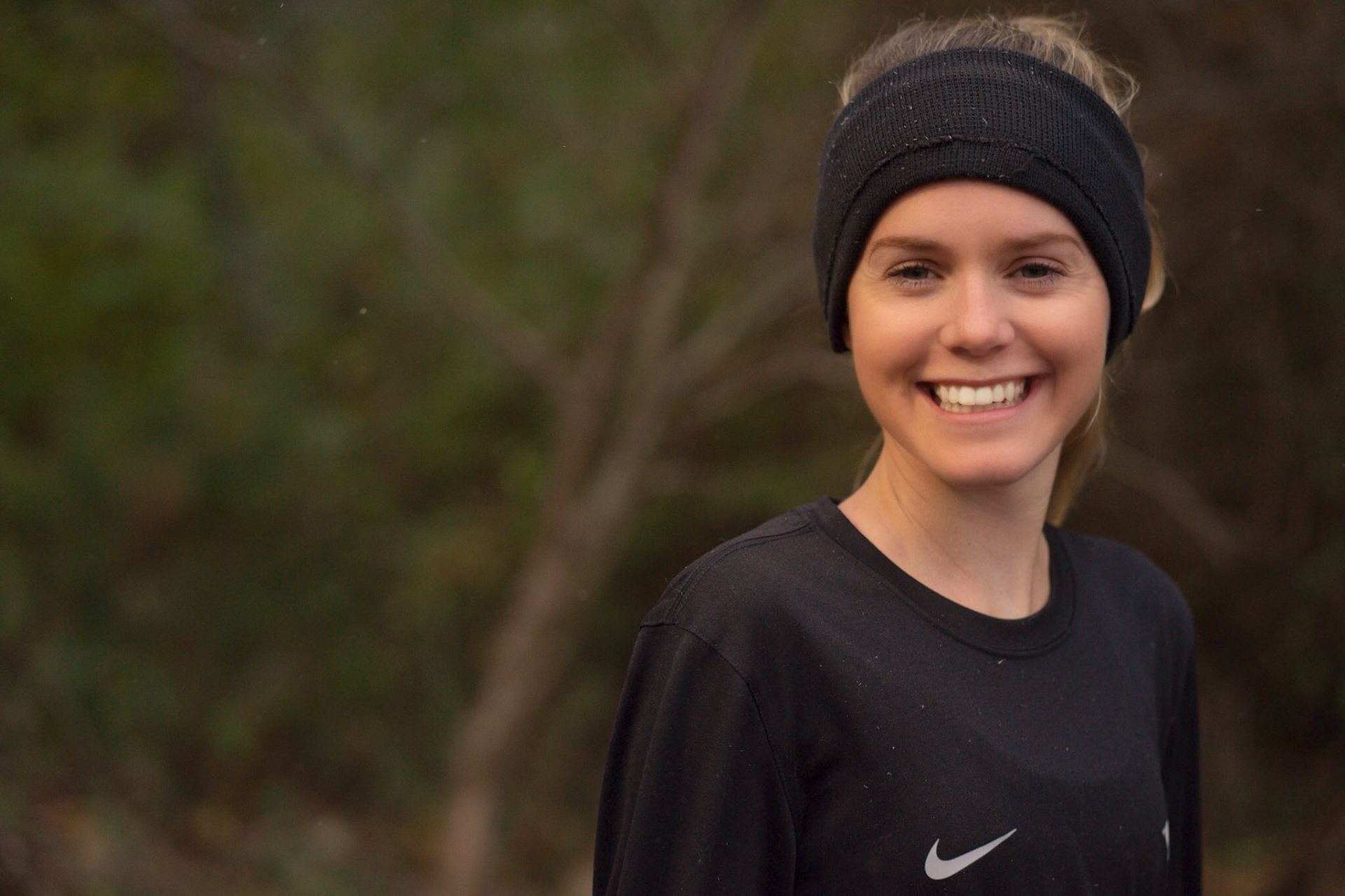
Katrina Robinson is an undergraduate student of biomedical engineering and also a track-and-field athlete. Below she discusses cross-country success, academic drive, and shares advice for similarly ambitious students.
BME: When did you first become interested in biomedical engineering?
Robinson: To be completely honest, not until September last year. I came into college unsure about what exactly I wanted to study, but I knew that I really enjoyed science classes and that my strongest classes were ones involving critical thinking. After settling in during the fall and thinking a lot about what was right for me, I decided that biomedical engineering would be perfect. It was the perfect blend of science and math and becoming an engineer really excited me. It also opens up doors into the health field which I have always been very interested in.
BME: Why the University of Arkansas?
Robinson: Growing up as a track runner in Australia, I always knew that I wanted to pursue my passion for running at an American college. The sport is so much bigger here than at home and the opportunity to run on scholarship was also one that I couldn’t pass up. The University of Arkansas has such a renowned track program and when I took a visit here during my senior year I fell in love with the campus and fit right in with the team.
BME: What classes or labs have you enjoyed most?
Robinson: I have really enjoyed taking University Physics 1 this semester because I find physics to be such a fascinating subject. I like how tangible the science is and the fact that you are learning about concepts that you encounter in everyday life. I also loved taking the Principles of Biology class last semester because I find it interesting learning about the inner workings of the body.
BME: How do you balance being a student athlete and a biomedical engineering student?
Robinson: I developed a lot of good habits in high school which I have been able to carry with me into college. It can definitely be tough trying to balance a full course load while also fitting in hours of practice each day and having to miss a lot of school days travelling to meets, but I always try to plan out my week in advance to figure out the best times to study. I try to set aside small but consistent study sessions throughout the week instead of trying to cram it all in at one time, because I find this helps eliminate stress and gives me time each day to do other things I enjoy.

BME: Any advice for other student athletes who are studying biomedical engineering at the U of A?
Robinson: Classes can get stressful at times, so my advice is to remember why you are studying biomedical engineering in the first place. It is such a fascinating program that can lead to so many exciting careers, and reminding myself of this always helps motivate me when I feel weighed down with exams and homework. My other piece of advice (which is easier said than done) is to complete homework and start studying for tests as early as possible. This will make every course seem a lot more manageable and will eliminate a lot of stress.
BME: Do you feel that your success as an athlete and a biomedical engineering student complement each other? Where do you think this ambition comes from?
Robinson: I think they definitely complement each other because both require a lot of hard work and commitment. Just like studying, running each day can be tough and there are definitely days when a hard workout is the last thing I feel like doing. However, learning to put in the hard work consistently each day is what has helped me achieve my best results both on the track and in the classroom. I also find that running is a great way to destress when school feels overwhelming and it always helps me clear my mind. I have always been very ambitious which I have been able to apply to all aspects of my life.
BME: Any plans after graduation?
Robinson: After graduating, I plan to keep running and to hopefully be competitive at an Olympic Games. I don’t have any specific academic plans yet, but as I continue with my degree and explore the different aspects of biomedical engineering, I hope this will become clearer.
BME: What has been your proudest moment thus far in college?
Robinson: My proudest moment was being named SEC Freshmen of the Year during cross country season and also placing second at the cross-country Pre-Nationals in Wisconsin in a strong field.
Apr 27, 2019 | Awards

Pictured above: Department Head, Raj Rao, with Biomedical Engineering students and mentors.
University of Arkansas’ State and National Awards Reception is held yearly at the end of the spring semester and commemorates the academic achievements of students in various departments. The Biomedical Engineering Department claimed several notable awards for both students and the department overall. Below is a list of the recipients and their mentors.
- The Biomedical Engineering Department won the 2019 Departmental Gold Medal, received by Department Head, Raj Rao.
- Harrison Dean won the Summer Undergraduate Research Fellowship from the American Heart Association, mentored by Heather Walker.
- Alaa Abdelgawad was recognized for her Student Travel Award from the Biomedical Engineering Society, mentored by Narasimhan Rajaram.
- Smit Patel was awarded the Hagan Scholarship, mentored by Kartik Balachandran and Charles Robinson.
- Mason Buele was recognized as an Outstanding Chapter officer by the National Biomedical Honor Society, mentored by Michelle Kim.
- Various students won the National Science Foundation Research Experience for Undergraduates, including Olga Brazhkina, Jarrod Eisma, Jessica Orton, Jack West, and Lucy Woodbury. They were mentored by Morten Jensen, Connie Lamm, Jamie Hestekin, Bryan Hill, and Kyle Quinn, respectively.
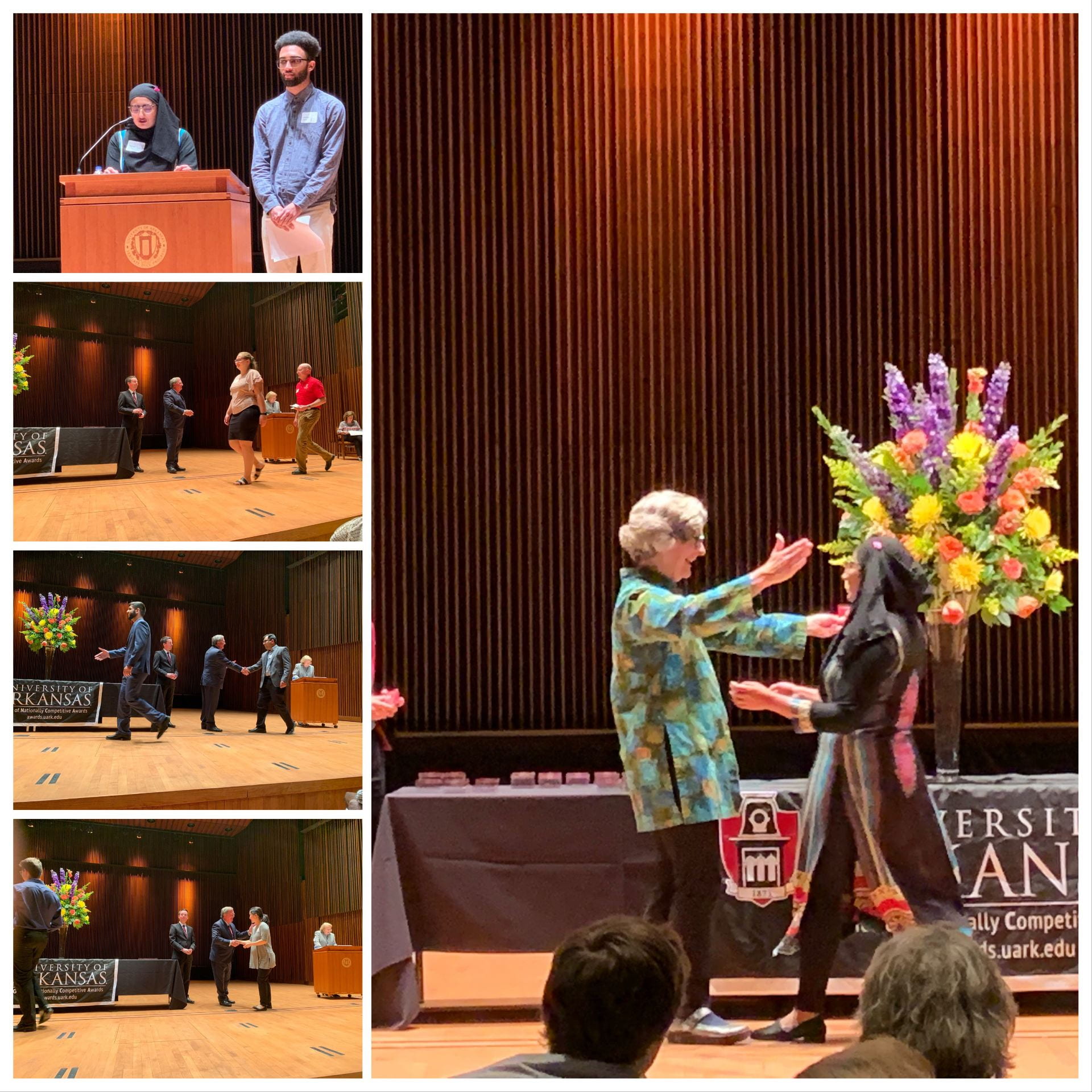
- Jessica Orton was also awarded the Student Undergraduate Research Fellowship (SURF), mentored by Jamie Hestekin.
- Harrison Dean was also recognized for his acceptance into Texas A&M College of Medicine Summer Research Program, mentored by Heather Walker.
- Samia Ismail was awarded the Truman Scholarship, mentored by Nicole Clowney.
- Smit Patel was also recognized for his acceptance into the University of Arkansas for Medical Sciences Summer Undergraduate Research Program, mentored by Kartik Balachandran.
- Andre Figueroa won the Upstate Medical University Summer Undergraduate Research Fellowship, also mentored by Kartik Balachandran.
- Alaa Abdelgawad was also awarded the UT Health San Antonio Summer Research Fellowship, mentored by Narasimhan Rajaram.
- Gianna Busch was recognized for her acceptance at Vanderbilt Biophotonics Center Summer Research Program, mentored by Kyle Quinn.
Apr 23, 2019 | Conference Diaries
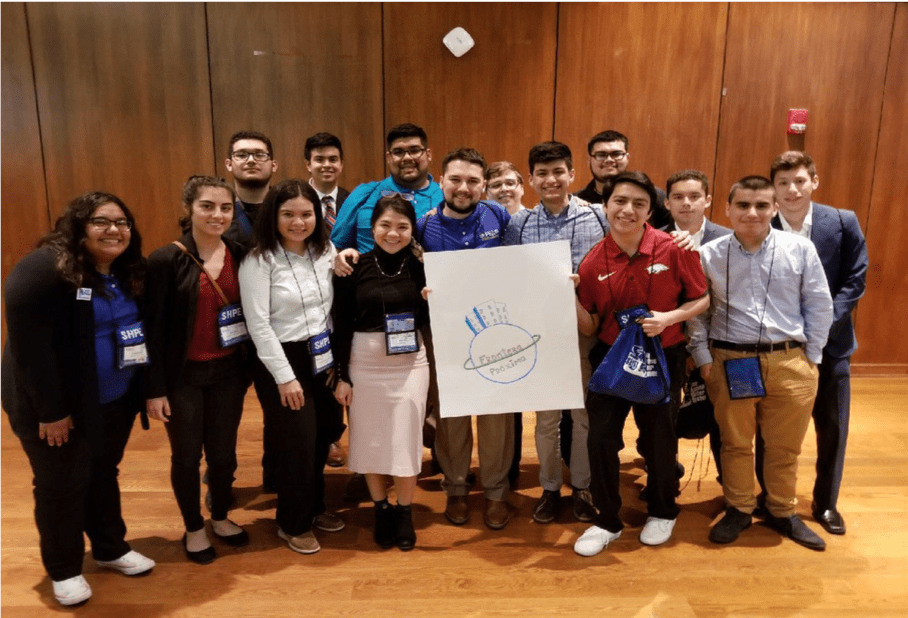
Engineering competition at the RLDC 2019. The winners were University of Arkansas, University of Texas at Austin and University of Texas at Arlington.
Alexandra Gutierrez is an undergraduate studying biomedical engineering. Below, she recounts her experiences at the Regional Leadership Development Conference held by the Society of Hispanic Professional Engineers.
My name is Alexandra Gutierrez, I am a senior biomedical engineering student and it was not until my junior year that I realized the importance of being involved with the different RSO on campus. I am currently part of the Panamanian Student Organization (PSO), American Indian Society of Sciences and Engineering (AISES), and the Society of Hispanic Professional Engineers (SHPE).
In particular, I would like to share my experience at Regional Leadership Development Conference (RLDC) 2019, organized by SHPE and held at St. Mary’s University, University of Texas in San Antonio, TX. Soaring for success was the Conference’s main theme. At this conference, not only was I exposed to meeting new people, participating in an engineering competition, a protagonist of the multiple workshops held by SHPE to develop leadership skills, and part of a career fair for networking opportunities, but also RLDC participants were fully inspired to impact the community through STEM as well as guided by experienced leaders. At this conference, there were many interesting workshops, but the most relevant workshop sessions for me were: “SHPEOLOGY” and “Hacking Your Professional Brand While Being Authentic”. “SHPEOLOGY” was conducted by Monique Herrera, the corporate director of relations and marketing of SHPE. In SHPEOLOGY, she explained that the Hispanic community in the workplace is reduced because there is a lack of knowledge from Hispanic people about the professional and leadership opportunities that are offered for Hispanics every year. Thus, it is important for more Hispanics to join this “Familia”, as she called it. Here, they can access these opportunities more easily. Raising awareness about the values and diversity Latinos to bring to places, such as the workplace and academia, might be an effective solution to diverse problems this society faces. With this solution, she invites every Hispanic to strive for the best and never give up while joining this organization to spread the word.
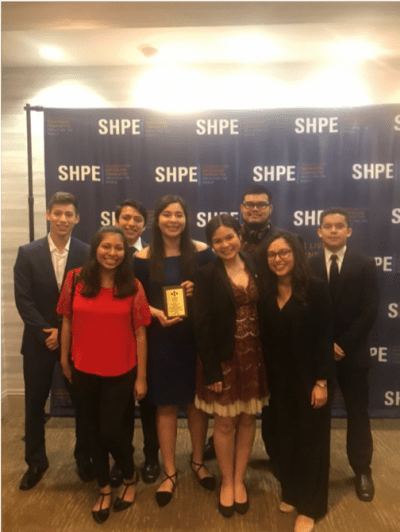
The University of Arkansas chapter was recognized as the most improved chapter in the region.
The other workshop was named: “Hacking Your Professional Brand While Being Authentic”, Rodney Tobares, the speaker from the Facebook Company. His message was based on building a community to bring more Latinos/Hispanics closer together through technology. During his years at the industry, he relied on the power of becoming his own brand, and he encourages everyone to do the same. Collectivism, sympathy, respect, cultural identity, fatalism, and paternalism have been the Latino cultural strips from which he has used to share his Hispanic heritage. He mentioned that we need to have defined steps in order to reach our goals. He suggested a platform called “Piazza”, which is designed to connect professionals and academia. The career fair was also an important component of this conference. Here, Hispanics were able to interact with professionals from a variety of companies, give their elevator pitch, and be led by professionals to their possible industry interests as well as academic paths.
Overall, these workshops brought more awareness to me and my desire to invite everyone to join this society while in college. I am thankful for having had the support from the BME department. Hispanics and any individual can benefit from events like this conference, and others such as the National conference coming in the fall of this year. Come and be part of our Familia!
Mar 12, 2019 | Conference Diaries
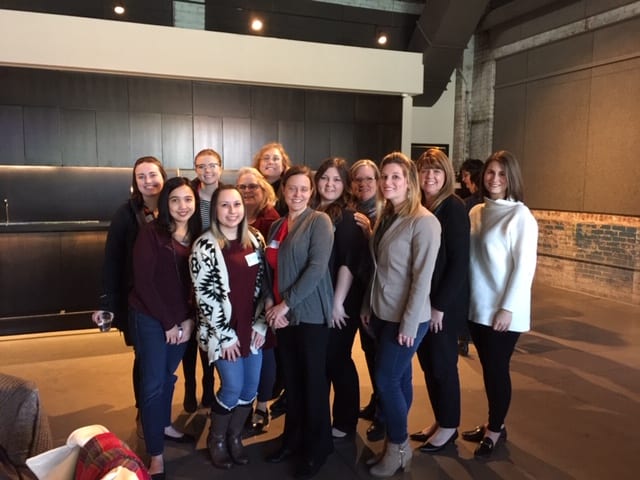
Pictured above: UAF engineering staff at Women in the Workforce Annual Conference on March 6, 2019 in Bentonville, AR
As part of Women’s History Month, Tori Marie Stover—Fiscal Support Analyst for the Biomedical Engineering Department—offers a summary of the Women in the Workforce Annual Conference held on March 6, 2019 and the various sessions that were presented.
The theme of this conference was Purpose, Performance, and Persuasion. Their description: “This one-day, interactive conference provides female professionals with an opportunity to enhance relevant workplace skills. Hear from industry veterans on topics that align with this year’s theme.”
Keynote Speaker:
“This thought-provoking session on leadership style specifically is geared towards women, focused on 6 Key P’s: Performance, Persuasion, Purpose, Passion, Presence, and Perception.”
- The first session was with Keynote Speaker Merrissa Pires, VP of Human Resources at Rickett Benckiser. We were asked to speak with another attendee about who we are at our best and worst, and how we remain our best during our worst times. This allowed us to reflect on who we really are, and made us think about our passions, and what makes us feel powerful. She asked us to think about how a child would perceive us; children tend to see greatness in everything, which was very thought provoking. Then she provided us with a quote, “Gallup analysis reveals that people who use their strengths (passions) every day are three times more likely to report having an excellent quality of life, six times more likely to be engaged at work, 8% more productive and 15% less likely to quit their jobs.” This engrains that how we perceive ourselves, and the things we are passionate about, have a huge impact on us. With that said, she pointed out that women often tear themselves down, when they should be lifting themselves up. This is a great reminder for anyone; your quality of life matters, and you shouldn’t be so hard on yourself.
Workshop:
- We chose between two workshops: Discover Your Purpose: Emi Cardarelli, Director Club Sales and Sustainability at Unilever and Discover and the Impact of Storytelling in the Workplace: Shannon Petersen, Director of Human Resources at Hilti. I chose to attend the latter, since the former sounded similar to the keynote speaker, and I wanted to learn something different. This presentation’s purpose was to give us a deeper understanding of the power of storytelling and how to use it to connect with co-workers, customers, and supervisors. Shannon shared her story of a medical scare that forced her to spontaneously go on short-term disability leave, and how her supervisor was supportive and encouraged her to come back to work afterwards. By the end of the story, the whole audience felt a connection to Shannon and her experience. As an exercise, she had one half of the room ask each other a set of questions, then the other half answer a different set. The first half were simple questions about favorite actors, and pets, while the second half was about our goals and other personal questions. Her point was that the more complex and personal a question or story is, the more in-depth the answer or reaction will be. As a result, you will feel more connected to the other person. She uses this method to hire employees, or sell a product, but it can be used in any situation where you are interacting with another individual.
Panel Discussion:
- Silvia Siqueria, Diversity and Inclusion Officer at Hilti, brought a panel of presenters to discuss the importance of workplace diversity. At first, they began with gender diversity, but it quickly began to include age and race as well. They answered several questions from the audience about how to handle situations, ranging from what to do when someone is clearly excluding you for being different than them, to when someone is trying to make you comfortable, but ends up making you more uncomfortable. The example given for the latter was, an African American woman had started a position and had items removed from her list of duties, because her supervisor didn’t think she would be comfortable handing it. All of the responses were thoughtful, but the most helpful piece of advice, was to write it down and have a conversation about it later. Tell them how it made you feel and ask if this was their intention. Silvia said from her experience doing this, she usually gets the response, “Of course not, I didn’t even think about it that way”. This opens a dialogue about the issue, and allows the other person to understand how their words or actions can be misconstrued, so they can be more thoughtful about the way they behave in the future. I think this piece of advice can be helpful to anyone who is having a conflict with a co-worker or supervisor.
The day ended with a drawing for some goodies, and closing words by the MC, Kristy Meinzer, Senior Manager of Performance Content, and VMLY&R.
Feb 14, 2019 | Questions & Answers

![]()
Ishita Tandon is biomedical engineering doctoral student at the University of Arkansas and a recent recipient of the American Heart Association fellowship. In the Q&A below, she discusses her history with biomedical engineering, work-life balance, mentorship under Dr. Balachandran and collaborative research with Dr. Kyle Quinn and his lab, among other things.
UArk BME: Did you always know you wanted to study biomedical engineering?
Tandon: Yes, I did! My parents are both doctors. My dad is a plastic and cosmetic surgeon and a burn specialist. I grew up with the idea that there is a dearth of affordable and sustainable skin scaffolds for burn patients and I wanted to do stem cell research and come up with a solution. Therefore, I took up biotechnology as the optional subject during my high school and did my undergraduate in biotechnology as well. After that, I came up here and have been enjoying my research as a PhD scholar.
UArk BME: You were recently awarded the American Heart Association Fellowship for your research into calcific aortic valve disease. Congratulations! What drove you towards this research?
Tandon: The research proposal we submitted for the American Heart Association Fellowship deals with using multiphoton imaging as a tool for early detection of aortic heart valve calcification. Our lab researches the early mechanisms involved in the aortic valve calcification. This research is important as the diagnostic technologies used in the clinic like ultrasounds, diagnose the disease at a later stage when irreversible damage has taken place. So, we wanted to come up with detection tools that applied to the early stages of the disease so that the intervention could be made before irreversible damage of the tissue occurs. In addition, Dr. Quinn had the technology of multiphoton imaging, which had applications in cancer and stem cell research. Therefore, we collaborated to see if the technology could be used as an early detection tool and be applied in the heart valve disease field as well.
UArk BME: What’s a typical day like for you as a PhD student? How do you balance the demands of your research with other responsibilities?
Tandon: Usually, my day revolves around the research. I try to be home by evenings and not spend odd hours in the lab, to maintain some work – life balance. The way we set expectations in our lab is by setting deadlines to get the research goals completed, irrespective of how and when we get it done. This setup gives us the flexibility of working at our own pace and time and enhances our productivity and work quality. It also helps us maintain the balance and get some personal time.
UArk BME: What made you choose the University of Arkansas for graduate school?
Tandon: I loved the fact that it was a new and growing department and the research projects going on were exciting. I had initially applied for a master’s degree. Dr. Kartik offered me a PhD position and I was intrigued when we discussed about the research opportunities. I was also drawn to the peaceful and serene vibe of the town with a nice climate.
UArk BME: Your research specifically focuses on early detection methods. Could you elaborate on what this research entails, and how it will help those diagnosed with the disease?
Tandon: Our lab focuses on creating multiscale platforms like 2-Dimensional or 3-Dimensional organ-on-chip models, animal models and biomaterials for tissue engineering applications. For my research, the organ-on-chip device and the animal model is used to simulate the healthy versus the diseased condition of the valve. The cells and tissues are then imaged using the multiphoton microscope and metabolic readouts are obtained. The goal is to correlate those readouts with the metrics, which are established in the literature in order to test the hypothesis that the multiphoton metrics could be used for early detection of the aortic valve calcification. My study serves as a proof-of-concept and would need rigorous validations before it can start benefiting patients directly. I believe, in short term the metric would be more useful in research to enable a longitudinal study in-vitrowith repeated measures given the fact that the imaging technique is non-destructive, label-free and provides quantitative data. Eventually, with the minimization of the imaging setup and further validation of the metrics, this detection strategy, may have a shot in clinics.
UArk BME: Which faculty members have you worked most closely with in your research here? What has it been like working with them?
Tandon: I work in the mechanobiology and soft materials lab with Dr. Kartik Balachandran. I feel blessed to be under his guidance. I hope to pursue a career in academia and Dr. Kartik is the ideal mentor and professor. He serves as a role model in terms of a lab PI, a professor, an administrator and a mentor. Having that mutual respect and understanding is pivotal when it comes to such demanding undertakings as a PhD.
For my current project, I have closely worked with Dr. Kyle Quinn and his lab. I enjoy their work ethic and determination. He gives us the extra push that is sometimes needed to speed things up and realize that we are competing in a highly competitive industry. So many times Dr. Muldoon and Dr. Wolchok have helped me and guided me through questions about microscopy or statistics. The professors in this department make it a safe and peaceful environment to be productive, train yourself for the future and not actually feel the pressure of outside world.
All the professors are supportive of each other’s research and the overall development of each student.
UArk BME: What have the greatest challenges been in you research work so far? How have you overcome them?
Tandon: One major challenge I have faced is that I get excited about all the cool research going on that it gets difficult to focus on one project. I want to take them all on. I want to learn all the different concepts and techniques and be a part of as many projects as I could. I tend to take new projects on without really finalizing the previous ones. The way I am trying to manage it, is by realizing the fact that the research associated with your name is the one that is published and materialized. We need to keep in mind that what we are doing as scientists is in long term for the benefit of society and needs to be accessible to them in some published form. I know many students suffer from the same issue on different levels and at some point we have to commit and see a project through, despite all the troubleshooting and technical challenges it entails.
UArk BME: What’s your favorite part of being a PhD student at the University of Arkansas?
Tandon: Umm, everything. I can list a couple of them. UArk offers something for everyone. Whatever our taste be in terms of reading, sports, music, arts, science, there is a place for everything. I have always loved to be a part of the extra-curricular activities and respect the fact that there is so much to do here when I need it. I also appreciative that our BMEG department is a small family unit where we all work and enjoy together. We have had activities like ping-pong tournament and department outings. People get along and strive to succeed all together.
UArk BME: Do you have any advice for undergraduates who might wish to pursue a graduate degree in biomedical engineering?
Tandon: In my experience, two most important things as an undergraduate hoping for graduate school are 1. having a strong understanding of the fundamentals and concepts in the field and 2. getting research experience in a lab. The grades drive the study patterns of most students and they tend to cram up and selectively study to just get the desired grades. I feel the focus should be to understand the concepts and soak in the knowledge. Academics is like a growing tree. If the roots are deep and strong, the tree is going to flourish and fruit well. For someone aspiring to pursue a graduate degree, they should definitely get some lab experience. The earlier during the undergraduate the better are their chances to be a part of the publications, to make them competitive for a graduate position.
Oct 14, 2018 | Internships
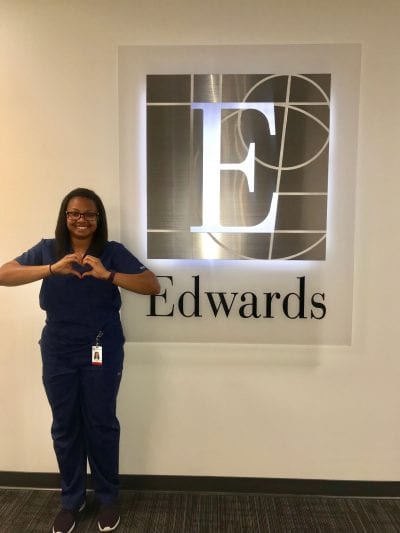
Kristianna doing the signature Edwards’ heart hand sign outside on of the testing labs
Kristianna Jones is a biomedical engineering student at the University of Arkansas. During the summer of 2018, she was a Quality Engineering Intern for Edwards Lifesciences in Irvine, California. Below, she describes what a typical day was like, what surprised and impressed her, and what she took away from the internship:
This past summer I was fortunate enough to work as a Quality Engineering intern on the Pilot Operations team with Edwards Lifesciences! I got this amazing opportunity from attending the National Society of Black Engineers (NSBE) 44th National Convention this past March. My internship lasted for 10 weeks, May 21st through August 3rd, in Irvine, California and every day was like a brand-new adventure. Of course, working for one of the top medical device companies seemed a little nerve-wracking at first, but I was honestly a lot more prepared for industry than I originally thought.
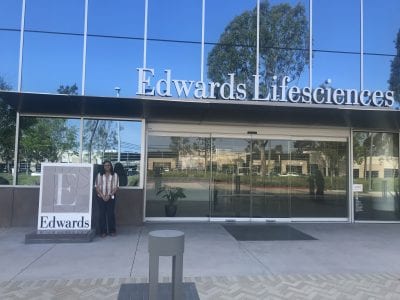
Kristianna Jones outside the Irvine Campus during her first week at her internship
As a quality engineering intern, I got to experience how they ensure the safety of each product before it was sent to the market. I learned how thorough the process is—from checking the quality of the raw goods to the checks built into the manufacturing process to the final inspections and tests conducted after the product is completed, everything is truly done with a “Patients First” mindset.
A typical day for me started at 7:30am with the daily manufacturing meeting. Even though I’m not a morning person at all, I always found these meetings interesting and insightful because I was able to get a quick overview on ALL of the transcatheter heart valve (THV) products, not just the one I was supporting. Besides the morning meeting, two days never really looked the same. One day, I even got to be a surgeon and implant an aortic valve into a pig heart! My manager was mostly hands-off besides our weekly one-on-ones, so I decided what I did on a daily basis and that just depended on what projects I needed to work on that day.
(more…)










